When I was about 6 years old, I finally got to participate in an Easter tradition in which I begged to partake every year: my Sicilian great-grandma’s roasted lamb’s head. With my dad and uncle, I was invited upstairs to her apartment on the third floor of my grandmother’s house in Queens, New York. (The rest of my extended family, perhaps more sensible, stayed downstairs snacking on chocolate eggs.) I remember feeling so grown-up, like I was part of a family tradition that went back generations before me.
Now, older and wiser to the potential health risks of eating sheep’s brains, I have never felt compelled to resurrect that particular tradition. But for me Easter remains a season that is about both celebrating Christ’s resurrection and honoring our families through our shared practices. When we asked U.S. Catholic readers about their favorite Easter traditions, their answers echoed my own experiences.
While no one reported eating anything like a roasted lamb’s head, U.S. Catholic readers described celebrating Easter and Holy Week with special meals, fellowship, and family traditions. Ham, Polish sausage, leg of lamb, lamb cake, and deviled eggs were common foods, along with the ubiquitous Easter chocolate.
Many of people’s favorite traditions revolved around spending time with loved ones. “My favorite tradition is preparing Easter foods on Holy Saturday with my kids,” says Teri Krowka of Richmond, Virginia. “I love watching my adult children going to the meat market and then coming home and baking, putting butter crosses on the breads and palm crosses in the blessed butter we have on our table. . . . My parents worked so hard to pass on Easter traditions and rituals to us, and I hope my children will continue to do so with their families.” Likewise, Daniel Gandert of Chicago fondly remembers family Easter egg hunts. “When I was little, I would hide Easter eggs from my cousins in places that were really difficult to find,” he says. “One of my favorite memories is watching my family try to find them.”
Other survey respondents had experiences that resonated with my own feelings of family belonging across the generations, tied together by our Easter practices. Ruth Hroncich of Brookfield, Illinois says that in her house the tradition is a passed-down Easter basket. “My granddaughter’s Easter basket at my house was first mine, then her mom’s, and now it’s hers,” she says. “My father decorated it when I was a child.” Kim Zarif of Berlin, Maryland says that Easter allows her family to bring together both her and her husband’s unique cultures. “My husband was born in Syria, so with his family—who recently escaped the civil war in Syria—we combine the Eastern rites with the Roman Catholic ones on Easter,” she says.
For Zarif, experiencing another culture’s Easter celebration has deepened her own faith. Likewise, for many people Easter is a time to experience the diversity of our Catholic faith. Like many families, my family was often traveling over Holy Week, and we often attended Easter Mass at an unfamiliar parish. I had the opportunity to experience Good Friday services at my grandma’s mostly Polish parish in Queens and sunrise Easter Mass on the beach in North Carolina. At one predominantly black church in the South, the service ended with a liturgical dancer dressed as Jesus “rising from the dead” and the entire church dancing along to “Jesus Christ Is Risen Today.”
Each respondent of the U.S. Catholic survey had their own unique parish traditions. William Scott of East Northport, New York reports that at his parish the high school youth group always acts out the Good Friday gospel. At Colleen Flack’s church in Cleveland, the parish decorates an Easter tree inside the church. Joyce Donahue of Joliet, Illinois describes how her parish engages in social justice work during Holy Week, saying that she takes part in a “Good Friday justice walk that includes stops at the jail and homeless shelter.” And Cindy Trainque of Leominster, Massachusetts says, “In my parish during the Easter Vigil we are encouraged to bring our own bells to church and ring them loudly during the Gloria!”
For other Catholics, Holy Week is a time to take part in ecumenical and interfaith worship. Maureen McCarron of Conesus, New York says, “I like to attend other denominations’ Easter services—as well as my own parish’s—just to see how they manage the symbols, to hear their pastor’s homily, and to experience the Eucharist (if they celebrate the Eucharist). I also like to hear the music in other churches.” Several people described how their Easter celebration includes a Seder dinner in recognition of our Jewish brothers and sisters and in memory of Jesus’ Last Supper. Clement Ward of Stillwater, Oklahoma says that he “participates in a community interfaith series during Holy Week.” And Catherine Koletsky of Cambridge, Massachusetts says that her parish “hosts a Seven Last Words service, where people from different denominations speak on one of the seven last words of Christ.”
Some respondents said their favorite thing about Easter was the beauty of the Holy Week liturgies. Val Keller of Everett, Washington says her favorite memory of Easter is the Easter Vigil service. “As the paschal candle enters into the dark church,” she says, “I reflect on how Jesus always breaks through the darkness.” Others list Tenebrae services, foot washing on Maundy Thursday, and the Good Friday service as personally meaningful liturgies. Robert Lincoln from Dike, Texas says, “After Christmas, Easter is my second-favorite liturgical time of the year.”
For others, the significance of the season is in the theology rather than in the family traditions or liturgical practices. “Easter reminds me that we are a resurrection people and our hope is in the Lord,” says Trish Rice of Fountain Valley, California. Likewise, for Eva Lyons of Wilmington, Delaware Easter is a time to “celebrate our salvation with joy.” She says that “it is a yearly reminder that even though we are in the middle of the story, we know it will end in eternal life.”
Perhaps not surprisingly, one of the biggest splits in responses centered around people’s attitudes toward the Easter bunny. Several people listed the Easter bunny as one of their least favorite Easter traditions. “It secularizes the sacrifice of our Lord,” says Linda Shenk of Euclid, Ohio. For others, however, the Easter bunny reminds them of celebrating as a child. “My favorite memory of Easter is my father trying to get us to go to bed by making ‘hopping’ noises against the wall,” says Joyce Naumis of Lawrenceville, Georgia. “He would try to make us think that the Easter bunny was on his way.”
Easter bunny or no Easter bunny, lamb cake or lamb’s head, despite their different traditions everyone who participated in our survey agrees that Easter is a time of rebirth and commemoration, a time to celebrate Jesus’ resurrection while also remembering his death and the death of those family members who have gone before us. As Candy Krepel from Milwaukee says, “Easter blends a celebration with the memories of the people who are gone and the presence of the people who are still here.”
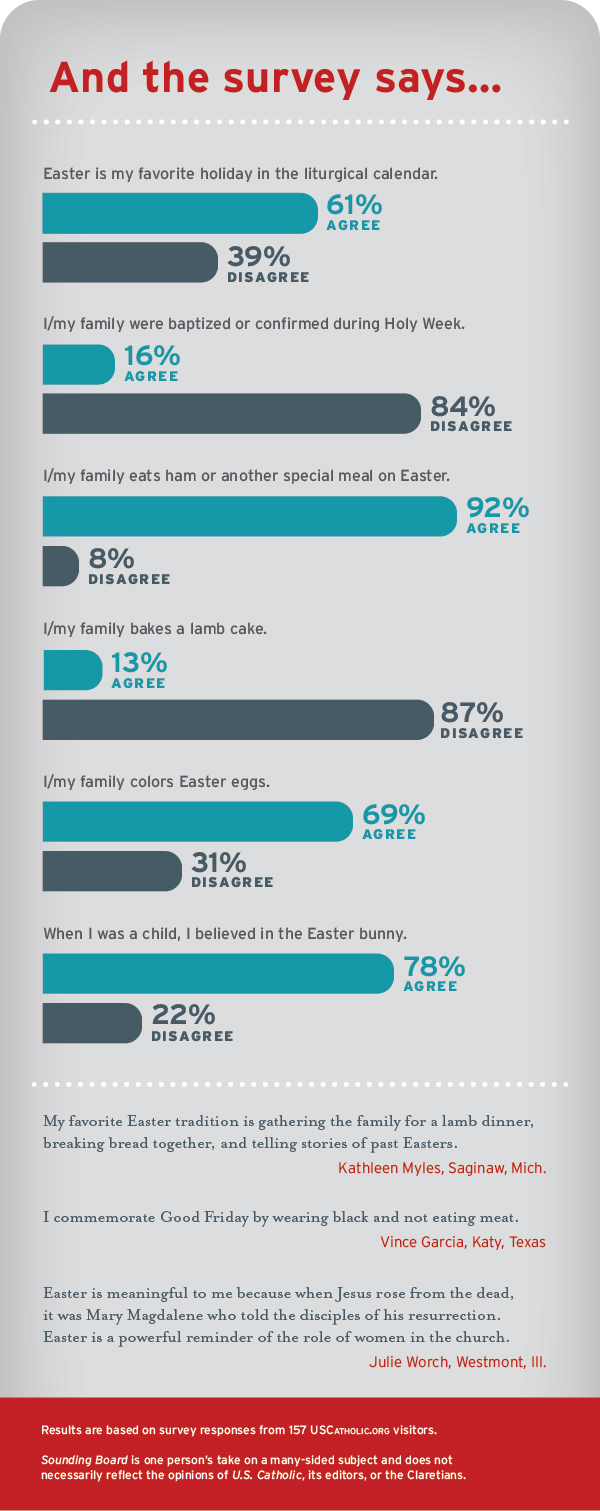
This article also appears in the April 2020 issue of U.S. Catholic (Vol. 85, No. 4, pages 33-35). Click here to subscribe to the magazine.
Image: iStock


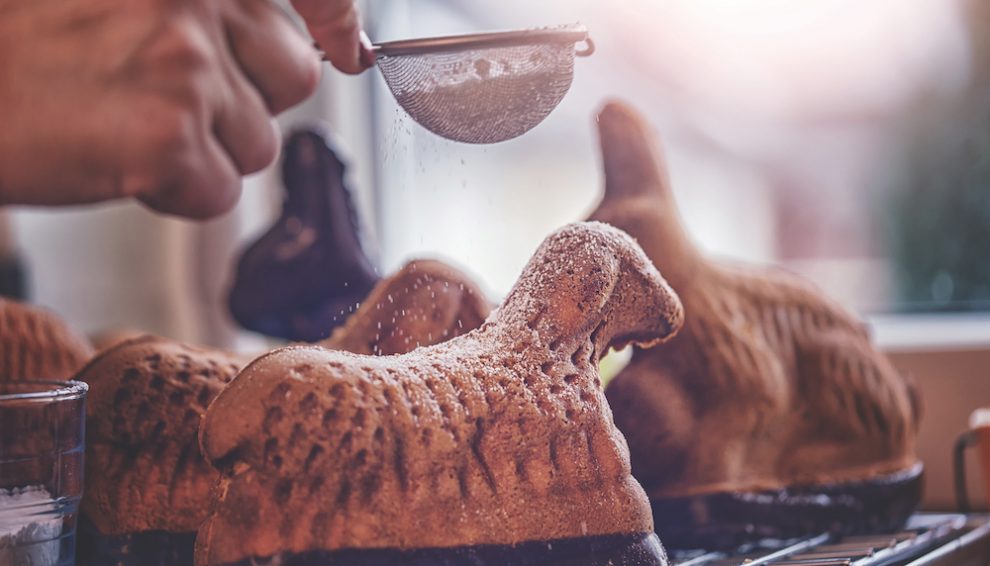


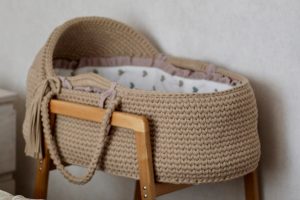
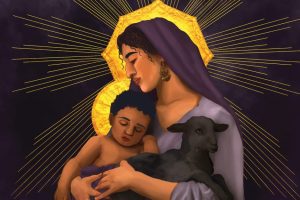
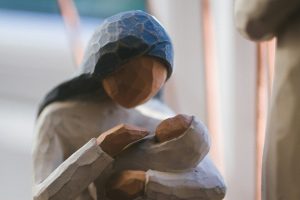





Add comment